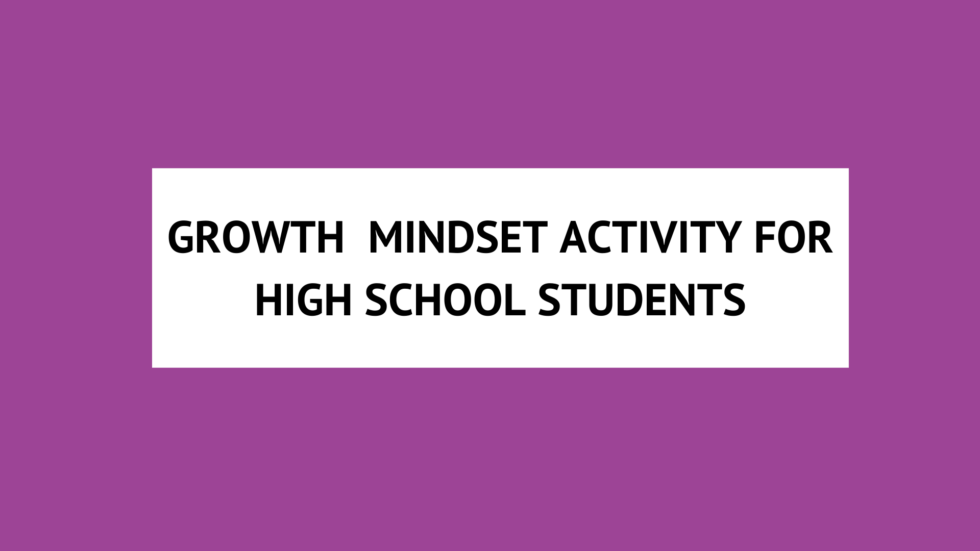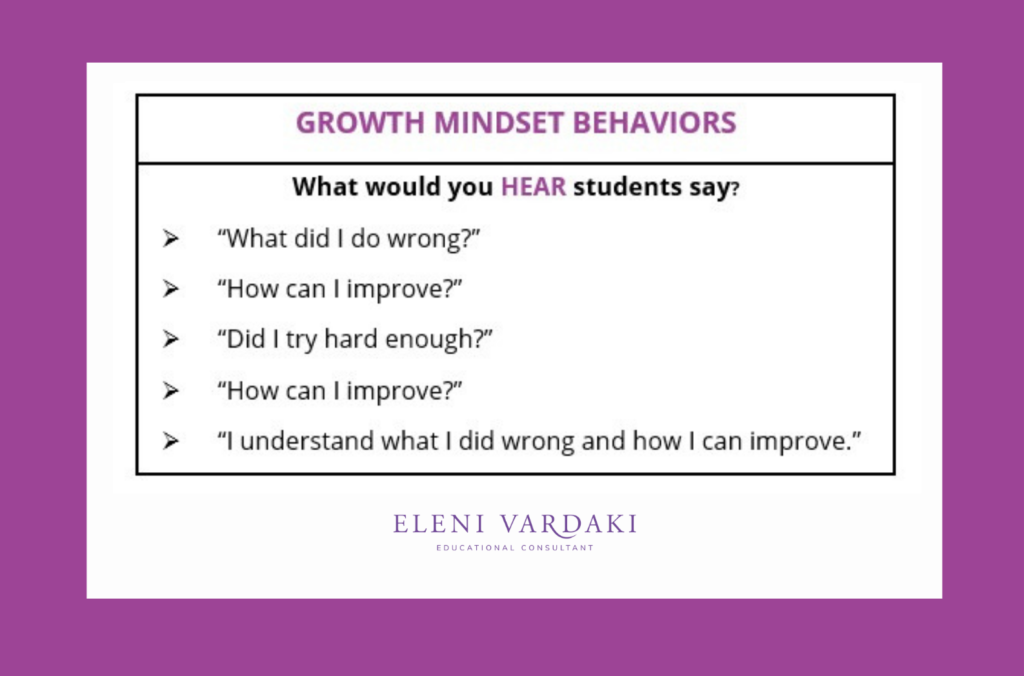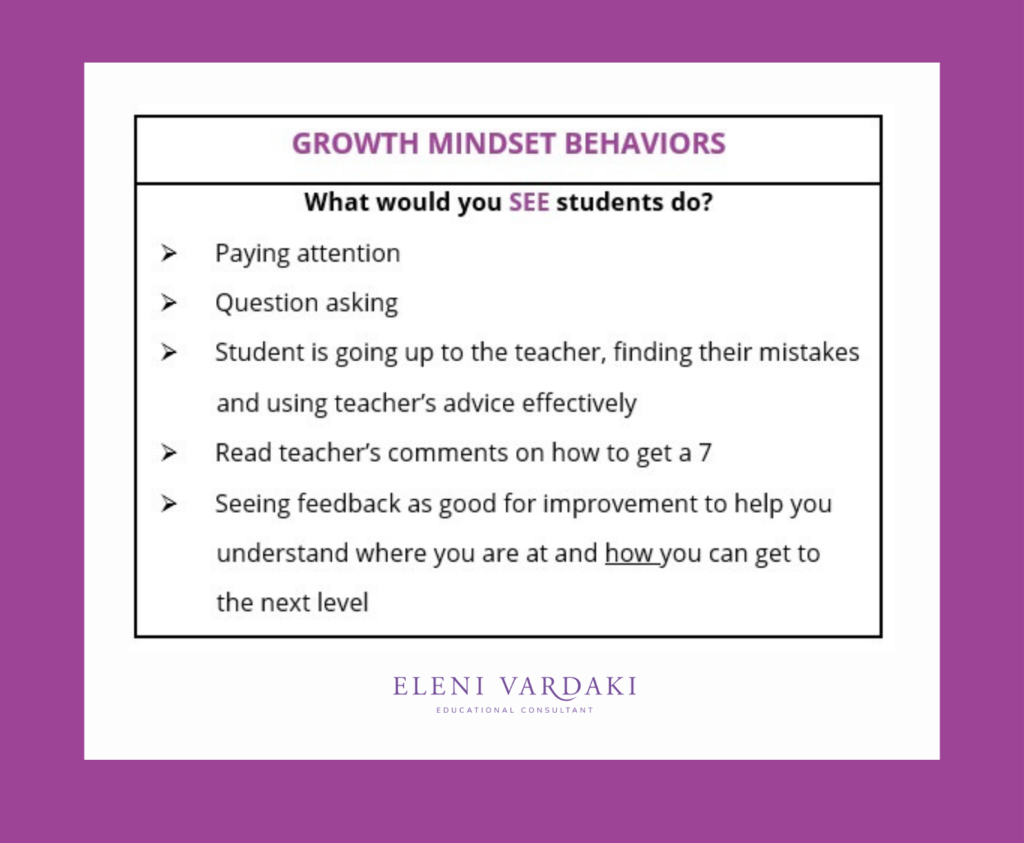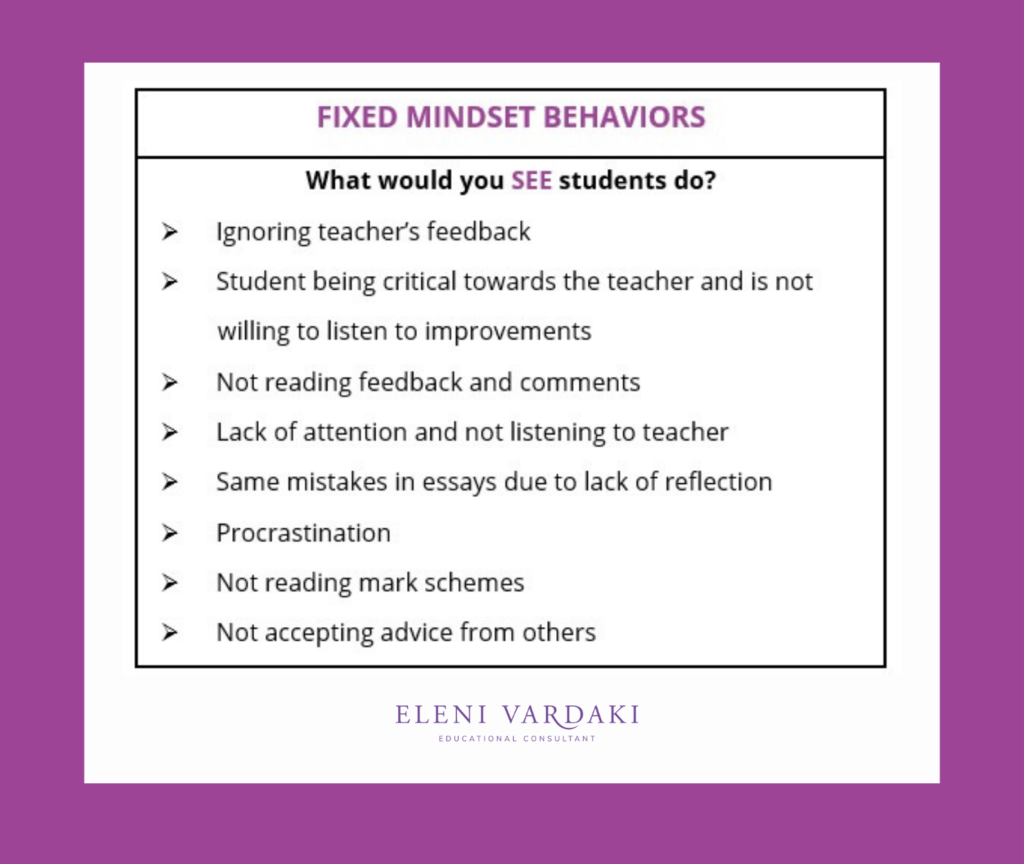
Growth Mindset Training in Class
WHAT’S THE ISSUE: Tired of seeing your students completely disregard all the work you put into giving them meaningful feedback on their tests / exams / research projects / coursework? Try this short Growth Mindset training starter activity for feedback lessons out and see if it helps refocus your class around your class values of a Growth Mindset towards receiving feedback.
We know that mindset matters when it comes to students being able to achieve independence when learning, revising and studying. And it certainly matters when it comes to whether your students actually make the most of good quality, constructive feedback that is designed to move them forward; learners with a Fixed Mindset aren’t usually open to receiving constructive feedback on their academic progress. And that can certainly get in the way of their achieving their academic potential, either in the short-term or in the long-term.
In this article, I share an example of a simple summative assessment Growth Mindset activity I’ve done with Grade 12, which could easily be applied all the way down to a Grade 9 class. I also share printable resources and activities that teachers can get their High School classes to do. By sharing what I’ve found works in my teaching practice, I hope to inspire other teachers to come forth and share the Growth Mindset activities you’ve tried with your with students, and with what outcomes.
HOW DO WE KNOW IF STUDENTS GET WHAT THEY NEED TO DO IN ORDER TO HAVE A GROWTH MINDSET?
“What for me, personally, is wrong is the approach to Fixed Mindset and Growth Mindset in schools. It’s the same in all of the schools I’ve worked at when they try to teach Fixed Mindset and Growth Mindset to kids. Nothing is sinking in. All you’re doing is guilt-tripping them. ‘Oh you have the wrong mindset. If you had the right mindset, you wouldn’t think like that.’ It’s just old school shaming. The majority of students don’t get it. They don’t get what they need to do, in order to have a Growth Mindset.”
British / International School teacher
Most of us who have worked in good British or international schools are aware of the importance a Growth Mindset plays in student’s academic and holistic growth. While trainers often come into school selling the academic growth value of a Growth Mindset, it’s hard to see how a balanced, holistic student learner profile could occur without a Growth Mindset. A Growth Mindset has a positive impact on a student’s well-being, and a class made of more students who have a Growth Mindset is a far more positive and happy learning environment for all.
However, one of the mistakes we make as educators (and I admit to being guilty of this at the start of my career) is to assume that students actually know what they have to do, in order to have a Fixed Mindset. How can stop assuming, and move from a reactive, unplanned (‘Now dear, is that a Growth Mindset or a Fixed Mindset you’re displaying there with what you say?’) approach to teaching the Growth Mindset to a more proactive, thoughtful approach?
GROWTH MINDSET ACTIVITY APPLIED TO RECEIVING EXAM FEEDBACK
I’m aware of the huge pressure on us as educators to cover the vast curriculum required for us to properly prepare our students for rigorous exams and assessments. For many years, I taught content-heavy exam groups preparing for challenging exams, like the IB History Grade 12 exam. So I get it. I can totally relate with the ‘I don’t have time for anything but getting through this exam curriculum’ thoughts.
I also know, from experience, that when we let go of some of our own general stress and insecurities as educators, we can make time to be present for our students’ emotional and psychological needs. And when are able to do so, they make quicker progress academically, as well as holistically, becoming more balanced and well-rounded individuals who have a positive impact on other people.
But for that to happen, we have to stop jumping right into teaching more content, or giving back mock exam feedback, and make time for a more thoughtful approach to learning how to embody the Growth Mindset.
CONTEXT: GRADE 12 IB HISTORY MOCK EXAM FEEDBACK LESSON
The Grade 12 responses to a Growth Mindset/Fixed Mindset exercise were completed by former Grade 12 History students of mine, before receiving my feedback on the first of the 3 IB History past papers that they completed as part of their mock exams. They had 3 months to reflect on and act on that feedback in order to improve their knowledge and essay writing / source analysis skills for their final exams in May.
I’ve learned from experience that starting the mock exam feedback lesson with an exercise that prompted relevant reflection was important for setting the tone of the feedback lessons to one that maximized the chance of students approaching their feedback from the benefits of a Growth Mindset. I also knew that they were so exhausted and stressed from studying so hard for their mock exams (and sometimes pulling all-nighters, trying to cram revision in last minute, under great distress), that giving their mock exams back and launching straight into the feedback is often counter-productive.
I’d already taught this class the importance of mindfulness for effective revision, when helping them prepare for their IGCSE History exams in Grade 10. So there wasn’t any point repeating my Mandarins, Mindfulness and Mock exams starter activity with them. They already knew the importance of mindful studying. What I didn’t know was what their understanding of what a Growth Mindset looked like. It dawned on me that I’d never done any activities on that.
GROWTH MINDSET ACTIVITY AS MOCK EXAM FEEDBACK LESSON STARTER ACTIVITY
As a quick 10 minute started activity, I decided to start the lesson by handing out some post-it notes. They then jotted down what came to mind when they thought of what a fly on the wall would…
- Hear a student saying
- See a student doing
…which suggested the student was embodying the Growth Mindset versus the Fixed Mindset towards learning and receiving feedback.
I asked them to imagine what a ‘fly on the wall’, looking into any given classroom, would see and hear students SAYING and DOING, that would suggest they had a Growth Mindset versus a Fixed Mindset. The idea was to bring in that mindful, external observer effect. I wanted them to depersonalise what they were ‘seeing and hearing’ as they observed the behaviors they were describing in a more matter-of-fact, objective way.
Taking into account the lack of mobility in that particular classroom due to space limitations, I adapted the activity from what I would have liked to have done, if space weren’t an issue (getting students to put their post it notes up on the wall under ‘Mixed Mindset’ and ‘Growth Mindset’ categories, split into ‘what would you see?’ and ‘what would you hear?’ sections), to what actually could be done in that particular setting (taking in their post-it notes, and reading them out for students to identify common themes and set the tone for the feedback to come.
WHAT STUDENTS SAID: GRADE 12 STUDENTS DESCRIBE GROWTH MINDSET AND FIXED MINDSET BEHAVIORS
“Feedback is a gift…Because it is. It clearly is. It’s not meant to hurt. It’s meant to move things forward, right? To demystify something. I want frank feedback from everyone, and I get it. ”
Tobi Lütke, CEO of Shopify
I didn’t really know what to expect my Grade 12 students would say, because I’d never done this kind of Growth Mindset / Fixed Mindset activity before. I’d certainly seen signs of Growth Mindset in many of my students. But I hadn’t done an activity like this to get a better sense of the level of their understanding with regards to how Growth versus Fixed Mindset behaviors towards feedback differ.
The idea to do the activity came to me the night before I taught this lesson. I intuitively felt a pull to try it out and see how it goes.
When I read my students’ responses, I was struck by how perceptive and precise their conceptual understanding of the Fixed and Growth Mindset was!
Have a look at what they said:




LESSONS LEARNED
PLEASANT SURPRISES
The first thing I learned from this experience is how valuable it is to get students to verbalize the difference between Growth Mindset and Fixed Mindset behaviours. In this case, they were Grade 12 students, but you can easily do this exercise with a Grade 9, 10, or 11 class to get a sense of how far they understand what they need to do in order to have a Growth Mindset.
Second, it was a valuable exercise for bringing the class together around the shared value of striving to embody a Growth Mindset after a school timetable disruption. I hadn’t seen them for more than 5 weeks (3 weeks off-timetable doing mock exams, plus 2.5 weeks off school to revise over Christmas break). So it actually worked really well to help regroup and refocus the class around the shared values of Growth Mindset behaviors towards feedback.
Perhaps most importantly, I learned that students were able to describe what to do to have a Growth Mindset far better than I ever could! Which was a useful reminder to me as an educator on the importance of creating space for student voice, and learning from our students.
HUMBLING REALIZATIONS
Overall, was this 10-minute starter activity enough to transform the Fixed Mindset of two of the students in that class into a Growth Mindset before their final exams? No. Of course not.
It’s unreasonable and unethical for us (or governments, or parents – or anyone, for that matter!) to expect teachers to solve deep psychological problems with educational tools. When Fixed Mindset blocks co-exist with addictions or mental illness, parents are responsible for getting their child the private support they need to overcome their mindset blocks.
It’s impossible for a classroom teacher, burdened by the pressures of getting through a big curriculum, to be all things to all people. Our responsibility as classroom teachers is to provide accessible educational self-reflection opportunities for our students to learn about the benefits of the Growth Mindset.
Particularly in cases were a student may be suffering from an addiction (e.g. alcoholism, recreational drug abuse, gaming) or a life-threatening mental illness (e.g. anorexia, cutting themselves), we have to draw a line in the sand. We have to remember that some issues are more than just educational or well-being issues that can be dealt with by simply drip-feeding Growth Mindset training and mindfulness training into our lesson plans and schemes of work.
Students and parents must take responsibility for getting themselves/their child the right kind of specialist support, when the learning blocks go deeper and requires a therapeutic (rather than just an educational) intervention on the part of the classroom teacher or school.
There is no quick-fix to complex student well-being problems that are getting in the way of their academic and holistic education. Some students need specialist, sustained support in order to cultivate a Growth Mindset, in the face of any extraordinary stress they may be experiencing that’s keeping them stuck in a Fixed Mindset.
OVERALL, WAS IT WORTH IT?
Absolutely! By the end of January, our students are exhausted from having sat through grueling mock exams at the start of their second semester of school. As teachers, we are also exhausted from having spent endless hours marking and reflecting on meaningful feedback we can give to help them prepare for their finals.
Anything that helps students stay calm and receptive to guidance and support in these conditions during mock exam feedback lessons is invaluable.
The benefit of sacrificing just 10 minutes of exam feedback time for a quick little Growth Mindset reflection task was a deepening of focus and receptivity to constructive feedback as we went through the mock exams and I explained what pitfalls to look out for, and how best to answer each question in order to gain full marks.
Because the last thing you want, as a teacher, is to have spent endless hours marking mock exams, only for the majority of your students to ignore all the feedback you painstakingly sat down to give them and only care to look at their grade.
The majority of students in that Grade 12 class successfully co-created a calm and productive atmosphere that allowed them to respond to my feedback in a Growth Mindset way. So taking a less hate, more speed approach and adding in that short 10 minute Growth Mindset exercise to see it have a positive overall on the class atmosphere was (I personally think) certainly worthwhile.
WHAT GROWTH MINDSET ACTIVITIES HAVE YOU TRIED WITH YOUR STUDENTS?
My intention in sharing my reflections, experiences and resources is to inspire teachers who are doing activity-based Growth Mindset work in their classrooms to share practical examples of what Growth Mindset activities they’ve done with their class(es) as part of their Growth Mindset training, and what lessons they learned from that experience.
If you’ve got an activity or resource you have created or tried out with your students that you’d like to share on this topic of Growth Mindset training, and you’d like to write a Guest Writer article on it to showcase a sample of your students’ work, please send them over to eleni@elenivardaki.com
Let’s inspire each other and exchange Growth Mindset training good practice!
MINDSET TRAINING FOR STUDENTS AND STAFF
If you want more mindset training for your students and staff you can check out another educational article I wrote called “The Benefit Mindset: A Sustainable Solution for Schools.”
RESOURCES
Downloadable PDFs for High School teachers:
Research on Growth Mindset and academic success:
Dr Carole Dweck (2007) “Mindset: The New Psychology of Success”
Tobi Lütke’s reference to the importance of Growth Mindset for business success:
About the author

Eleni Vardaki works online to support parent, teacher, and student well-being. Her mission is to help bridge the gap between mainstream education and the wellbeing skills we need to thrive. She believes in doable, sustainable interventions for student wellbeing in school and family cultures that value student and community wellbeing.



